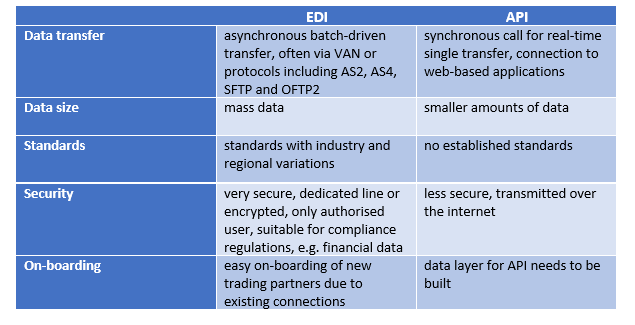EDI versus API
API and EDI are commonly used for data integration, and although they are both used to transfer and exchange data, they are two very different approaches. It is useful to know the differences in order to understand different software solutions and find out which data integration solution is needed to suit your business requirements.
Let’s have a closer look at the differences.
First of all, the main difference is that communication based on APIs offers more flexibility than standards-based data exchange with EDI.
To illustrate the differences, you can look at EDI as a traditional postal service and API as a telephone line. Letters are collected and delivered at a certain time, whereas on a phone you can call someone anytime. Via EDI, data is usually stored and then transmitted at particular times of the day, which means that data is not constantly being sent back and forth.
An API, however, enables information to flow from one side to the other at any time. With APIs, the connection is constantly available and able to transmit data in real-time. When a customer places an order, for example, an API call is made to send the information automatically to a back-office system in real-time.
How EDI works
EDI, or Electronic Data Interchange, has been the most popular communication technology for decades now. It is used to effectively transfer data from one system to another and offers businesses an easy and secure way to send data to their business partners electronically. It uses standardised formats that enable computer systems to easily process the information, greatly reducing or even removing manual labour.
Data can be exchanged in many ways. Some of the options include VANs (value added networks), dedicated lines between companies, although most of them are internet-based. As EDI solutions only give access to authorised users and follow rules and standards, they are very secure and are not prone to error. One reason for its success is that EDI is one of the safest ways to transfer data.
EDI enables companies to send large numbers of electronic documents with huge amounts of data at the same time in a single transfer. This does not only increase efficiency but also reduces errors, and subsequently saves time and cost.
As EDI minimises human intervention, computer systems have to be able understand the information that is exchanged. Hence, all parties have to adhere to a clearly defined standard format. Standards for layouts of common business documents such as ANSI, EDIFACT, TRADACOMS and ebXML make sending documents more efficient and reduce integration costs.
Clearly defined standards have a lot of advantages, but can be inconvenient in certain situations as well. Each of the standards has several versions, resulting in a large number of standards to choose from. This might be a challenge for smaller enterprises trading with larger organisations that use updated versions of the same standards. Another disadvantage of EDI is that some businesses that need to keep up with new developments in software technology, such as real-time visibility and responsiveness, are required to search for alternatives.
How APIs work
An Application Programming Interface, or API, is a set of rules and definitions that allows software applications to communicate with each other. Basically, like a user interface allows us to interact with computers, an API serves as an interface between software programs and helps them interact and communicate without any human intervention.
When buying something online, for example, you enter your credit card details to pay for the item online. The information is sent from the web-store via an API to a remote application, where it is verified. After confirming that your credit card details are valid, the application returns a confirmation to the web store so the order can be processed.
The main advantage of APIs compared to EDI is real-time responsiveness. In a supply chain scenario, for example, a shipping company’s system automatically receives a message via API that goods are ready to be collected, saving time and improving efficiency. Every step in the supply chain can be followed in real time, so each party is informed when an issue occurs and can respond accordingly. If the API you are connecting to supports webhooks, there is no need for polling a service for updates, instead you receive data when a particular event occurs.
EDI or API – What to choose
There is no straightforward answer - it mainly depends on the digital ecosystem of the company and its business partners.
While APIs have become hugely popular due to their adaptability to modern web-based applications, EDI, despite being an older technology, is still widely used as a standard for data exchange because of its security and reliability. In addition to that, having been adopted by many businesses makes it convenient when onboarding new trading partners, especially within the same industry.
For this reason, companies often do not have a choice, as the system or organisation they are connecting to mandates the data integration method to use. For many businesses that need to adhere to compliance regulations, for example due to the exchange of sensitive financial data, EDI is the most suitable solution.
APIs are innovative and offer a more powerful option for data exchange with web and cloud applications, as well as easy integration to back-end business systems, so an increasing number of decision makers prefer web service APIs to EDI due to their adaptability and responsiveness.
In some cases, both EDI and API are involved in an integration. For example, a retailer may mandate EDI, whereas the back-office system used by the supplier is only able to be connected to by API.
We may see APIs playing an ever-increasing role in data integration in the future, but for the time being EDI is here to stay. So, the solution is not either or – it often is both because both technologies complement each other.
